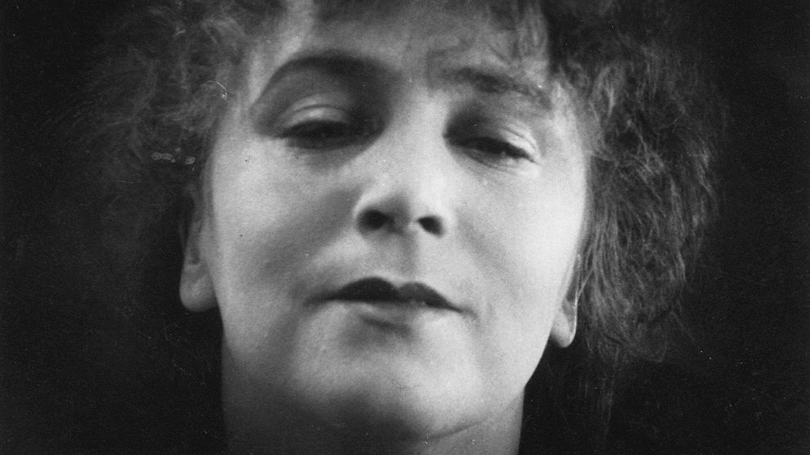Actress, née Clara Rasmussen, 23 April 1883 – 22 January 1975. First marriage in 1906 to the actor Carlo Wieth (1885-1943). The marriage was dissolved. Second marriage in 1920 to Povl Pontoppidan (1889-1953), a doctor. From 1906-1920 she was known as Clara Wieth, after that Pontoppidan.
Pontoppidan was admitted to the Royal Theatre’s Ballet School at age nine and made her stage debut in 1901. In the years that followed, she also went through the Royal Theatre’s acting school. From 1905-1925, she was employed by Dagmarteatret, interrupted only by a couple of years at Alexandrateatret (now Betty Nansen Teatret). From 1925 until her retirement in 1974, she was at the Royal Theatre.
Pontoppidan is remembered especially for her roles in pieces by three great playwrights: she played Salome in Kaj Munk’s En idealist (1928), Anne Sofie Hedvig in Kjeld Abell’s play of the same name (1939) and Mrs Gruesen in Soya’s Parasitterne (1945). Moreover, she shined in Knud Sønderby’s En kvinde er overflødig (1942), Gustav Wied’s Skærmydsler (both as Aunt 1 and Aunt 2) and as Sara Levin in Henri Nathansen’s Indenfor murene (1946).
Pontoppidan made her screen debut very early on. In 1902, when she was just 15, she danced a pas de deux with another ballet student in a brief film by Peter Elfelt. Later she became one of Denmark’s greatest silent film stars, surpassed only by Asta Nielsen (who made her career in Germany). Pontoppidan’s first real film role was in early 1910 for Regia Kunstfilm, but her career did not take off until the following year when she was hired by Nordisk Film. In the Hands of Impostors (1911), Temptations of a great City (1911) and The Vampire Dancer (1912), all directed by August Blom, made her a world-famous movie star.
In Dreyer’s second feature, Leaves from Satan’s Book (1921), Pontoppidan stars as Siri, the plucky, idealistic wife of a telegraph operator, who kills herself rather than let the Red Guards force her to lure the Whites into an ambush. The famous suicide scene is one long close-up of her face as she plunges the dagger into her heart. "The face that with its great expressiveness […] shines most clearly over this film is Clara Wieth’s," a contemporary critic wrote, using Pontoppidan’s then stage name. It remains a gripping, compelling performance. In her autobiography, Eet liv – mange liv (One Life – Many Lives), Pontoppidan described her collaboration with Dreyer,
"Dreyer! O have I been grateful and happy for the two films for him […]. In the first we had the good fortune, the three of us – Dreyer, photographer Schnéevoigt and I – to create the best close-up filmed at Nordisk Film for many years. That’s really what was said."
About the making of that famous shot, she writes, "I sat on a chair and looked straight into the device, but my entire mind was directed at Dreyer, there at the left. I was an instrument in his hands."
Once Upon a Time (1922) features Clara Pontoppidan as the princess of Illyria in a convincing turn as she descends from haughty princess to humble potter’s wife. Contemporary critics singled out her performance as the arrogant princess, while Dreyer’s stabs at comedy generally left them rather cold. In her book, Pontoppidan wrote about the film, "Dreyer’s genius marked the whole film and, while the reviews of the film weren’t particularly good, the public liked it." In 1921, she said this about Dreyer,
"And here I must immediately call attention to director Dreyer. He has been an exceedingly fine and understanding and gracious director."
Even so, the meeting of these two powerful personalities was not without problems, as is evident from the telegram she sent Dreyer on his 60th birthday: "Thank you for all the wonderful work moments and a bold strike through all misunderstandings."
With the arrival of sound films, Pontoppidan’s screen roles dwindled. Not that her voice was unsuitable for sound films, but she was devoting herself to the stage. In 1957 she played the lead in an adaptation of En kvinde er overflødig, a role she knew well, having performed it many times on stage. For the performance she won her only Bodil Award from the Danish film critics. In the 1960s, she had several supporting roles as loopy old ladies, notably in Støvsugerbanden (1963) and Slap af, Frede! (1966). She also reprised several of her stage roles in TV plays.
Pontoppidan had a unique career on the stage and screen. This petit woman with the characteristic profile may not have been a director’s first choice for leading lady or love interest, but she interpreted countless character roles in her naturalistic style. She had a knack for filling out her roles to make them multi-facetted and complex, bringing out the good in the evil, and vice versa. And she always imbued the indomitable bravado of her roles with tremendous psychological insight. She is the only Danish screen actor ever to celebrate 70 years in cinema.
